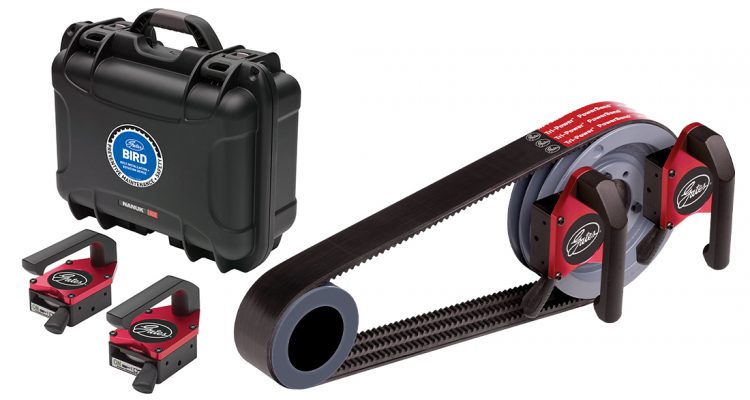Gates® invests in innovation to keep customers at the forefront of what they do. The company’s Belt Installation and Rotation Device (BIRD™) is in line with this mission, helping to protect equipment operators against pinch points during belt installation and maintenance.
The BIRD™ safely facilitates the rotational inspection of a drive when it is shut down and locked out. According to Rob Michelson, National Product Manager, Belts, Motion, the key function of the device is it avoids the need to manually pull on the belt to turn on the drive.
“The BIRD™ is like two magnetic handles,” he began to explain. “Most people roll the belts on when they’re doing an installation for a v-belt, which creates pinch spots. A lot of people have got fingers caught in this process. Rather than manually rotating the belt, the BIRD™ does the work by holding the pulleys during their installation and removal process, eliminating the risk of getting your fingers jammed between the belt and pulley.”
Before the BIRD™ was launched, operators would have to pull on the belt or grab the edges of the pulley to turn the drive. Regardless of the care taken, this was an inherently dangerous process. The costs to a business for a transmission installation accident go beyond hurting its workers, with direct medical expenses, loss of production, legal expenses, insurance premium increase and downtime all adding salt into the wound.
Drive and tension alignment are critical to ensuring a safe and efficient operation, so that issues like stray bolts flying off equipment are eradicated. Downtime at some plants can equate to tens of thousands of dollars, making reliability a key hallmark of Gates’ products. While the safety benefits of the BIRD™ are clear, it also works to improve equipment uptime through its predictive maintenance capability.
“The ROI on this type of technology is swift, because preventative maintenance is an easy way to see efficiency gains and productivity improvements,” Rob says.
Drive problems can occur if belts are not installed or maintained correctly, with one of the most common sources of these being misalignment. Enter EZ Align™ – Gates®’ laser alignment tool which uses patented and proven reflected laser beam technology.
“Pulley misalignment is a major issue behind belts failing prematurely,” he says. “A small error can cause the belt to wear out and fail and the traditional methods of using a string aren’t reliable enough when you can access better technology which takes less time.”
The system consists of two units – the laser transmitter and the reflector. Each unit is equipped with powerful magnet brackets.
“The Gates® EZ Align™ units mount magnetically to the face of most pulleys or sprockets. The transmitter unit projects a laser line onto the reflector unit, which is magnetically attached to the other pulley or sprocket face,” explains Rob. “This helps the technician ensure that the transmitted and reflected laser lines match with the respective reference lines.”
The proper pulley alignment is crucial to reducing downtime. The EZ Align™ comes with a red laser for indoors or a green laser for brighter outdoor environments to quickly and easily check the alignment of shafts, sheaves and sprockets.
A big advantage for Gates is its software platform Gates® Design Power™, which allows customers to work in collaboration with OEM partners to quickly and easily design the most accurate and suitable application-specific drive systems, saving time and money.
“It works as a great partnership with Gates® because they have the software packages so that we can do the drive analysis,” Rob notes. “We first punch in all of the details of the drive like the panel, speeds, sizes and so on and the program spits out the data on whether it’s sized correctly with the right tension. This gives customers an added layer of reassurance to the longevity of the drive.”
Rob says through this process a customer often discovers the drive is bigger than it needs to be, meaning they can reduce the overall cost while performing the same application. All in all, Gates®’ software can determine proper belt installation tension, calculate belt pull, determine the belt power transmission capacity, estimate the energy savings of a synchronous belt drive compared to a v-belt drive and the cost savings of replacing roller chain with a Poly Chain® belt. The built tension component is key, as the majority of belts which fail or burn out are caused by the improper tension.
Michelson added that working with Gates® is of huge benefit to Motion customers, as Gates® are constantly advancing products for the marketplace.
“Gates® are always at the forefront of innovation, developing new products and solutions to improve belt performance, efficiency and safety,” he says. “Fortunately for customers, they can benefit from Gates® solutions and technical expertise, in addition to Motion’s experience in power transmission solutions, and have access to this across the nation through our vast network of branches.”

